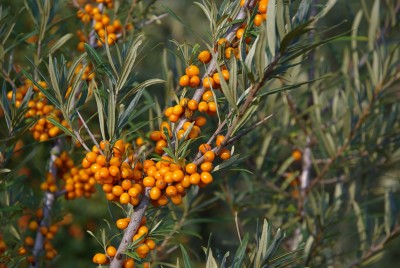Sea Buckthorn - Hippophae rhamnoides

Common Names: Sea Buckthorn, Siberian Miracle, Lemon of the North, Hippophae rhamnoides, Sandthorn, Seaberry, Buckthorn, Russian Sea Buckthorn, Sha Ji (Chinese origin), Oblepikha (Russian origin)
Latin Name: Hippophae rhamnoides
Origin: Asia, Europe
Short Introduction
Sea Buckthorn is a hardy medicinal plant that is easy to grow. Wild plants are often found along railway embankments and other less hospitable locations. It is excellent for soil stabilization and is tolerant of poor soils, thriving even in demanding conditions such as highways and clay soils. For a harvest, it is necessary to plant five female plants to one male, as Sea Buckthorn is dioecious, and sex can be distinguished at about four years old by the size of the buds. The plants are pollinated by wind and should be spaced 3 meters apart when planted. Sea Buckthorn is a long-lived plant, with lifespans up to 100 years, and is completely frost-resistant.
Detailed Description
Sea Buckthorn is a lifelong companion—for a healthy life.
Botanical Information
Sea Buckthorn (Hippophae rhamnoides) is a shrub or small tree that can reach up to 6 meters in height. It is a deciduous, dioecious plant with narrow green leaves. The upper side of the leaves is smooth and gray-green, while the underside is silvery and frosted in appearance. The oval, reddish-orange fruits begin to ripen in August, but are typically harvested in September and October. These berries cluster densely around the thorny branches, making them stand out as the true treasures among the foliage and thorns.
Origin and Distribution
Sea Buckthorn is native to Russia, but today it is widespread throughout Europe and Asia. In Siberia, it is known as the 'Siberian Miracle' due to its remarkable benefits for human health.
Usage / Dosage
Sea Buckthorn is prized for enhancing immune system resilience and is helpful during colds, viral infections, and sore throats. It is commonly used as a preventive measure against these illnesses. Its high vitamin content also supports liver health. Sea Buckthorn is suitable for treating hemorrhoids, improving pancreatic function, and recent studies have shown it may have anticancer properties. It aids the healing of peptic ulcers in both the duodenum and stomach. Regular consumption not only boosts immunity but also improves skin elasticity and strength. Faster healing of burns and frostbite has been observed, attributed to the presence of vitamin E, which is also credited with supporting women's health—alleviating menopausal symptoms such as hot flashes, mood instability, and headaches. Some sources note that vitamin E supplementation may delay menopause by several years, consequently postponing associated bone demineralization. Sea Buckthorn oil can also be added to baths to soften the skin. The plant may help prevent hair loss, and its amino acids contribute to maintaining and strengthening muscle mass, tendons, and nails. Thanks to tannins, it helps to neutralize free radicals—detoxifying the body. Sea Buckthorn also stimulates digestion and aids in eliminating harmful substances. For stomach problems, Sea Buckthorn is considered a first-line remedy. The tannins also reduce excessive sweating and are currently being studied for their potential to induce self-destruction of cancer cells.
The plant is suitable for long-term use.
One Sea Buckthorn berry a day provides your body with the recommended daily dose of vitamin C.
Active Compounds
Sea Buckthorn is especially rich in vitamin C, which plays a vital role in vascular health and iron absorption. One kilogram of berries contains up to 12g of vitamin C—up to 20 times more than found in other citrus fruits. Vitamin C is accompanied by vitamin P (rutin), which enhances its effect and prevents it from breaking down during drying, ensuring the dried berries retain their vitamin C content.
Other components include vitamins A, B, D, F, and K, essential oils, sugars, amino acids, tannins, flavonoids, carotenoids, carotenes, folic acid, phytoncides, mineral salts, and unsaturated fatty acids.
It is said that just one Sea Buckthorn berry can meet your daily vitamin C requirement.
Traditional Dosage
Steep 1 teaspoon of dried Sea Buckthorn berries in 250 ml of hot water for 10 minutes. The infusion can be sweetened with honey, or the dried berries can be added to other herbal teas for additional benefits. You can also eat the dried berries on their own, without any further preparation.
